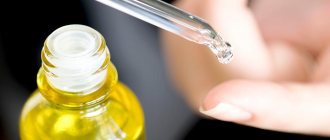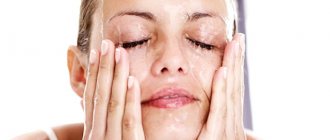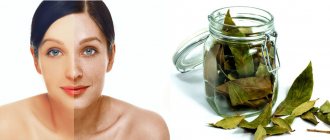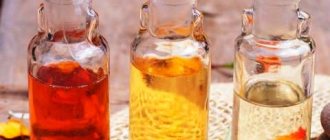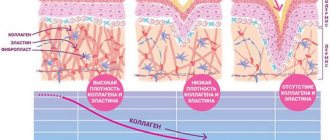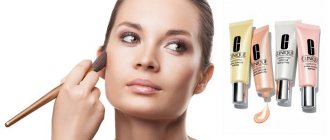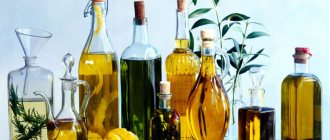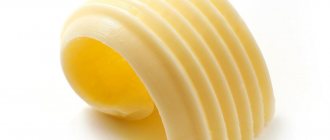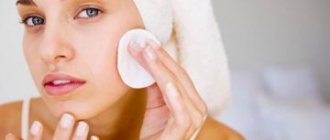This term comes from the word “comedone”. This is the name given to blackheads that spoil the complexion and appearance of the skin, and in advanced cases lead to the appearance of acne. They appear in both adolescents and adults - age does not matter here. To understand how blackheads arise, you need to get acquainted with the structure of the hair follicle.
Follicle is a depression on the surface of the epidermis within which hairs develop. In the lumen of the cavity, the sebaceous glands produce sebum, which lubricates the hair. When this duct becomes blocked, comedones form. If a favorable environment is created, they become inflamed and acne appears.
In adolescence, this is facilitated by increased production of sebum due to hormonal changes. In adults, in addition to disorders in the body, the problem is caused by incorrectly selected cosmetics, including vegetable oils.
Vitamins A and E can aggravate the condition of oily skin.
But not all oils are equally dangerous. The fact is that some of them are highly comedogenic, while others can be used to treat oily, inflamed skin.
Oils are 95% fatty acids, the presence of which explains why pores become clogged and sebaceous plugs form. Fatty acids are divided into three types - saturated, monounsaturated, polyunsaturated.
- Saturated fatty acids are thickeners, including in relation to sebum. But such substances are useful for dry, dehydrated skin, as they soften and prevent moisture evaporation.
- Oils with monounsaturated fatty acids are light, do not leave shine and penetrate into the deep layers of the skin, transporting beneficial substances there. It is believed that such products not only do not clog pores, but even dissolve sebaceous plugs, making the face cleaner.
- If polyunsaturated fatty acids predominate in the product, then they also penetrate well deep into the dermis, helping to maintain the fat barrier. But the disadvantage of these products is that they oxidize quickly and pose certain risks for oily skin.
Cosmetologists agreed that comedogenicity would be assessed using a five-point system. The table of comedogenicity of oils in Russian will tell you what score was assigned to a particular product.
These figures may fluctuate as they are affected by the degree of purification of the product. Thus, as a result of refining, the risk is reduced.
What is comedogenicity
This term comes from the word “comedone”. This is the name given to blackheads that spoil the complexion and appearance of the skin, and in advanced cases lead to the appearance of acne. They appear in both adolescents and adults – age does not matter here. To understand how blackheads arise, you need to get acquainted with the structure of the hair follicle.
Follicle is a depression on the surface of the epidermis within which hairs develop. In the lumen of the cavity, the sebaceous glands produce sebum, which lubricates the hair. When this duct becomes blocked, comedones form. If a favorable environment is created, they become inflamed and acne appears.
In adolescence, this is facilitated by increased production of sebum due to hormonal changes. In adults, in addition to disorders in the body, the problem is caused by incorrectly selected cosmetics, including vegetable oils.
Vitamins A and E can aggravate the condition of oily skin.
But not all oils are equally dangerous. The fact is that some of them are highly comedogenic, while others can be used to treat oily, inflamed skin.
Oils are 95% fatty acids, the presence of which explains why pores become clogged and sebaceous plugs form. Fatty acids are divided into three types - saturated, monounsaturated, polyunsaturated.
- Saturated fatty acids are thickeners, including in relation to sebum. But such substances are useful for dry, dehydrated skin, as they soften and prevent moisture evaporation.
- Oils with monounsaturated fatty acids are light, do not leave shine and penetrate into the deep layers of the skin, transporting beneficial substances there. It is believed that such products not only do not clog pores, but even dissolve sebaceous plugs, making the face cleaner.
- If polyunsaturated fatty acids predominate in the product, then they also penetrate well deep into the dermis, helping to maintain the fat barrier. But the disadvantage of these products is that they oxidize quickly and pose certain risks for oily skin.
Comedogenic scale and basic concepts
The scale ranks the likelihood that any specific ingredients, such as natural oils used in a cosmetic product's formulation, will clog pores. Anyone who is susceptible to pimples and blackheads should avoid the most comedogenic oils, as they can cause ongoing acne problems. However, people with drier skin may prefer an emollient oil that falls closer to the middle of the scale.
Non-comedogenic facial oils
These are oils that are assigned 0&minus.1 points on the scale mentioned above. They are liquid, flowing, light and suitable for any skin type, including oily and problem skin. The following are non-comedogenic facial oils, the list also contains a score.
| View | Points |
| Shi | |
| Safflower | |
| Sunflower (refined/unrefined) | 0/1 |
| Mango | |
| Hemp | |
| Argan | |
| Rosehip | 1 |
| Black cumin | 1 |
| Sea buckthorn | 1 |
| Neem (margosa) | 1 |
| Refined sesame | 1 |
| Castor | 1 |
| Pomegranate seeds | 1 |
What types of fatty acids are the best?
Vegetable and seed oils contain two types of fatty acids - linoleic acid and oleic acid.
Alpha-linoleic acid (omega-3) and linoleic acid (omega-6) are considered “essential fatty acids” because the body cannot produce them on its own. Oleic acid is produced by the body, so it is not considered “essential”.
Knowing the difference between fatty acids and how they interact with the skin will help you choose the most effective product based on your skin type.
Moderate and low comedogenicity of oils: table
These oils manifest themselves in different ways, and their effect on oily skin is unpredictable. You can find out the effect only by trying the product. On the scale they are assigned 2&minus.3 points.
| Type of oil | Point |
| Pumpkin | 2 |
| Tamanu | 2 |
| Sandalwood | 2 |
| Peach pit (peach) | 2 |
| Almond | 2 |
| Hazelnut (hazelnut) | 2 |
| Avocado pits | 2 |
| Camphornoye | 2 |
| Jojoba (liquid wax from nuts) | 2 |
| Grape seeds | 2 |
| Baobab seeds | 2 |
| Peanut | 2 |
| Apricot kernel | 2 |
| Cotton | 3 |
| Soy | 3 |
| Olive | 3 |
| Macadami | 3 |
| Unrefined sesame | 3 |
| Corn | 3 |
Normal skin type
- Normal skin is not particularly dry or oily.
- The pores are usually small, the skin does not shine, does not flake or crack. Typically there are a few wrinkles or lines.
- If you have normal skin, you should use products that do not strip the skin's natural oils, but moisturize, thereby helping to reduce wrinkles.
The best oils for normal skin include: argan oil, grape seed oil, hemp seed oil, jojoba oil, cherry seed oil.
Other substances
When buying ready-made cosmetics or planning to prepare a cream at home, you should keep in mind that in addition to vegetable oils, other fats are also used.
They, in turn, can also worsen the condition of the skin, especially if it is oily and has acne.
| Drug name | Point |
| Petrolatum | |
| Ceresin wax | |
| Mineral | |
| Candelilla wax | 1 |
| Carnauba wax | 1 |
| Beeswax | 2 |
| Emulsion wax | 2 |
| Shark liver oil | 3 |
| Lanolin | 3 |
| Mink oil | 3 |
Studies have shown that blackheads on the face also appear from the following components:
- isopryl palmiate,
- isopryl isostearate,
- sodium lauryl sulfate,
- hexadecyl alcohol,
- isostearyl neopentanoate,
- isopropyl myristate,
- isocetyl stearate,
- butyl stearate,
- Decyloleate.
Dry skin
Dry skin makes people feel tight, and the skin is often scaly and has flaky patches. People with dry skin have pores that are almost invisible. There are many factors that cause dry skin, from heredity and genetics to the amount of sebum produced in the skin.
If you have dry skin, you need to regularly moisturize it during your facial. You'll also need to avoid harsh cleansers, limit your time and frequency in hot showers, use a good humidifier in your home, and consider using products that contain humectants such as hyaluronic acid.
What benefits oily skin?
The following oils stabilize the condition of oily skin, eliminate inflammation and improve complexion:
- from hazelnut kernels - reduces pore size, smoothes, regenerates;
- grape seeds - moisturizes, makes pores less noticeable;
- jojoba - protects from ultraviolet radiation, retains moisture, nourishes;
- apricot kernels - restores elasticity, softens, moisturizes;
- baobab - clears acne, preserves turgor and youth;
- almond - cleanses pores, brightens redness.
Remember : it is impossible to replace skin care with oils alone, especially in adulthood.
And finally. The human body has its own characteristics. Therefore, we can only talk about comedogenicity as a trend. People may have different reactions to the same substance . Therefore, you should try the products carefully, even if the manufacturer promises that shea butter is of a low level of comedogenicity, especially if the quality of the product is low.
In addition, most products were tested on rabbit ears, and cosmetics do not always behave the same way on human skin. The problem also arises with an excess of fatty acids.
Some fats are necessary for the skin and can improve its condition even in advanced cases , since these substances are not synthesized by the body on its own. Therefore, it is a mistake to think that for oily skin, fat-free cosmetics are recommended; the composition should contain oils, but in the correct ratio. For oily and combination skin types, it is recommended to avoid using pure oils.
Oils and hair loss
It is strictly forbidden to apply oils to the scalp during hair loss, since: 1. Oils soften the mouths of the hair follicles and hair easily leaves the follicles under mechanical influence (in other words, they are pulled out); 2. Oils need to be washed off. This process is quite difficult, involving intense mechanical stress, which is contraindicated for hair prone to hair loss.
Therefore, if you use oil, then only when there is no hair loss (for prevention) and no more than once a month.
Take the test and find out how to help your hair
What else is useful to know about oils?
— Oils, like any natural product, can cause allergic reactions. Or you may discover an individual intolerance to certain components of the oil; — When buying pure oil, especially from the budget segment, you can never be 100% sure that it does not contain impurities that can cause not only allergies, but also serious problems with the scalp; — Pure oils are incompatible with hot styling, since vegetable oil simply burns under high heat. In addition to the unpleasant smell, it turns out that you are literally “frying” your hair; — Oil can remove dye and, therefore, wash out the color of dyed hair. To avoid this, you should not use oils both after and two weeks before coloring.
Degrees
A scale from 0 to 5 has been developed to assess comedogenicity. Where zero is the lowest and safest value, and five is the highest. The index concerns only oils in their pure form. In the composition of cosmetics, the value can be reduced due to the correct combination of components. Therefore, when choosing a pure oil, it is imperative to focus on comedogenicity indicators, and when purchasing synthetic skin care products, in most cases it makes no sense to pay attention to this.
Zero and low
These include oil products with comedogenicity indices of 0 and 1. As a rule, they have a liquid consistency and are easily distributed over the surface of the skin. They are used to cleanse and nourish oily and acne-prone epidermis. Those with dry and normal skin types can also use these products in their pure form. Let's look at the most popular oils with a low comedogenic index.
Shea butter (karite) - 0
Rich in hyaluronic, linolenic, palmitic, linoleic, stearic acids, vitamins F, K, A, E, PP and C. Blood circulation increases in the area where the product is applied, which triggers rejuvenation processes. The production of natural collagen and elastin is activated, resulting in the skin becoming elastic. The oil relieves inflammation, intensively moisturizes the skin, removes toxins and kills bacteria, which most often cause skin problems. With its help you can get rid of age spots.
Hemp oil – 0
Nourishes and moisturizes the epidermis. It can be used even by allergy sufferers. Hemp extract softens the skin and actively combats dryness and flaking. With its help you can cleanse your face of toxins. The antiseptic effect of the product helps stop the spread of infection on the skin. In addition, hemp oil normalizes the secretion of sebaceous secretions; this effect is especially important for oily skin. With regular use, density and elasticity increases. A healthy and even complexion is guaranteed to you. Women 30+ are recommended to use the oil to prevent premature skin aging.
Argan oil – 0
This product is especially appreciated by cosmetologists, manufacturers of care cosmetics and girls who like to prepare homemade remedies. Popularity remains despite the high cost. Contains a large amount of acids. Argan oil perfectly moisturizes the skin. Recommended for dry skin care. Regular use of the product slows down the aging process. The oil relieves inflammation, lightens age spots and evens out the complexion. It can be used as protection against the harmful effects of ultraviolet radiation.
Argan oil is hypoallergenic, so it is used to care for the skin of babies.
Mango butter - 0
The non-comedogenicity and other properties of the product allow it to be applied even to areas affected by acne. Mango extract is rich in vitamins C, A, E, D and members of group B, as well as micro- and macroelements: calcium, magnesium, potassium and others. The product moisturizes, nourishes, softens, heals, has an anti-inflammatory effect, and protects the skin from ultraviolet radiation. The skin after it becomes soft and elastic.
Rosehip oil – 1
Absolutely safe from a comedogenic point of view. It contains an extremely rare element - trenitoin, or trans-retinoic acid. Has high healing ability. It even fights the manifestations of eczema, dermatitis and psoriasis. Stabilizes sebum production and thereby cleanses the face of inflammation. Effective for dehydration, helps retain moisture and restores elasticity. Affects fine and deep wrinkles, eliminates peeling and irritation. It has a mild whitening effect and is effective against rosacea. For the body it is used to combat stretch marks.
Sea buckthorn oil – 1
Effectively fights wrinkles, relieves inflammation, disinfects the skin and improves regeneration processes. Sea buckthorn extract nourishes, moisturizes and evens out the complexion. This is a reliable remedy for peeling. Purulent inflammation disappears after the first use. If there are wounds on the face, the oil will help speed up the healing process. With regular use, you can forget about greasy shine. When performing a facial massage, it enhances the lifting effect. At the same time, it is non-comedogenic.
Ylang-ylang oil – 1
The components that make up the oil saturate cells with oxygen, enhance regeneration, and have a pronounced rejuvenating effect. The oil composition tightens pores and evens out skin tone, making it matte. Girls who are struggling with oily shine should definitely purchase this product. Non-comedogenic ylang-ylang oil is used to prevent acne.
Castor oil – 1
Works great on pimples and blackheads. Inflammation is relieved from the first use, and with regular use you can even remove acne marks. It has proven to be an effective remedy in the fight against wrinkles. A quick result can be obtained by using castor bean extract for crow's feet. Often used for scars and pigmentation.
Less popular types of oils with zero and low comedogenicity can be seen in the table.
| Safflower | 0 |
| Sunflower squeeze | 0 |
| Black cumin extract | 1 |
| Sesame | 1 |
| Pomegranate seed squeeze | 1 |
Moderate
This group is different in that the components can change their index depending on the user’s skin type and other factors. This means that for some they are suitable, but for others they cause irritation and blackheads. Let's look at the most popular oils and their properties.
Almond oil – 2
Has a nourishing and moisturizing effect. More suitable for dry skin as it can cause irritation and clog pores. Returns skin tone and slows down the aging process. Has an exfoliating and cleansing effect. It is used for allergic reactions to relieve itching and irritation. When applying oil, blood circulation in the affected area accelerates, which promotes better penetration of the components into the deeper layers. In summer you can use it instead of sunscreen.
Macadamia oil – 3
It should be used with caution on oily and inflamed skin to avoid unpleasant “surprises”. It contains many vitamins and minerals, as well as rare folate, which has a powerful anti-inflammatory effect. The extract normalizes blood microcirculation, prevents early aging, moisturizes the skin and normalizes water balance. Often used as protection against dryness and flaking of lips, elbows and heels.
Usually it is not used in its pure form, but is added to skin care products as one of the main components.
Olive oil – 3
It is actively used in food, however, it remains popular among lovers of home cosmetic procedures. Most often, nourishing masks are made with this product and added to moisturizers. Has protective properties. In summer, it is applied to the face shortly before going outside, as it filters harmful UV rays. In addition, the rich composition of the natural component saturates the skin with all the necessary elements to improve its condition.
This group also includes oils, which you can see in the table below.
| Avocado squeeze | 2 |
| Pumpkin | 2 |
| Sandalwood oil | 2 |
| Peach | 2 |
| Hazelnut extract | 2 |
| Vinogradnoye | 2 |
| Apricot kernel squeeze | 2 |
| Soy | 3 |
| Sesame | 3 |
| Corn | 3 |
High
These oils are also used in skin care, but usually as part of other products, or applied pointwise to areas where comedones cannot form. Most representatives of this group have proven themselves as hair care products. For the face they should be used with great caution. The cosmetic effect of them is good, but in most cases, using them in their pure form is more problematic than it is beneficial. Let's look at two prominent representatives of comedogenic oils.
Coconut oil – 4
This product is recommended to be used as a night moisturizer. However, it should not be used by girls with oily and problematic skin. The high comedogenicity of the oil guarantees an increase in inflammation. The opinions of those who have used the product on their facial skin vary. Some found salvation in it from flaking, dryness and dehydration. Others have developed clogged pores, allergies and other problems. Therefore, it is recommended to carry out a test on a small area to assess the risks, but it is better to use coconut extract as an addition to the main products. It is also suitable for hair restoration, but it is prohibited to smear the scalp.
Cocoa butter – 4
This is the strongest remedy against premature aging. It is hypoallergenic. This component protects the skin from negative influences. However, its high comedogenicity does not allow it to be used by everyone. It is suitable only for some female representatives. We recommend testing before use by applying oil to a small area of skin. If no reaction occurs, then you are one of the lucky ones who can experience the positive effects of this product.
Below is a table of oils with a high comedogenic index.
| Linen | 4 |
| Palm | 4 |
| Wheat germ | 5 |
Be extremely careful when using them!
Conclusion
Always remember that any oil can cause an allergic reaction, so do a quick test before use. To do this, apply a small amount of natural oil to a sensitive area of the skin. For example, on the bend of the elbow or the inside of the wrist. Leave the product on for 15 minutes to an hour, if after this time there is no redness, itching or swelling, the oil can be used. Otherwise, wash off the product immediately.
Also, do not forget to consult doctors who can more accurately determine your skin type and select the ideal natural oil for it.
